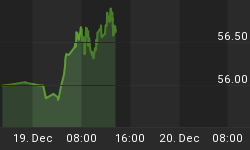In our last update, we expected short term weakness in gold followed by an upward reversal.
"In the short term, in order to avoid seeing gold close below $700, it must move above resistances of $780-810 relatively quickly and stabilize close to that range".
And we got exactly what was needed, although the metal is yet to stabilize near the $800s. Gold briefly touched $699, making a higher low, and continued to consolidate between $720 and $750. On Friday, gold spiked 57 points or almost 8% to its first resistance of $800.
While there is some resistance near $825-$850 for the short term, the weekly chart for gold is starting to look promising. But before the downtrend line (now between $900 and $920) is penetrated, we cannot say that the correction in gold is over and that the new stage of the gold bull market has begun.

Fundamentals remain exceptionally bullish on all fronts. Real interest rates are negative while inflation expectations have little room to go lower. A huge wave of fiscal stimulus is on the way.
The independent research house GFMS Ltd. had the following to say about gold demand: (source: http://www.mineweb.com/mineweb/view/mineweb/en/page33?oid=73404&sn=Detail)
"Dollar demand for gold reached an all-time quarterly record of US$32bn in the third quarter of 2008. Tonnage demand was also 18 percent higher than a year earlier".
"Identifiable investment demand, which incorporates demand for gold through exchange traded funds (ETFs), bars and coins, was the biggest contributor to overall demand during the quarter; it was up to US$10.7bn (382 tonnes), double the amount from a year earlier".
"Retail investment demand rose 121 percent to 232 tonnes in Q3, with strong bar and coin buying reported in Swiss, German and US markets. The quarter also witnessed widespread reports of gold shortages among bullion dealers across the globe, as investors searched for a safe haven. During the quarter, Europe reached an all-time record 51 tonnes of bar and coin buying and France became a net investor in gold for the first time since the early 1980s".
"Consumer demand for gold jewellery was also at a record with buyers coming back in to the market at lower price levels than previously, around and below $800. India (traditionally the world's largest gold jewellery consumer, with an average over the past five years of 21% of world jewellery demand), staged a strong recovery during the quarter, with the dollar value of gold in jewellery rising by 65% year-on-year".
"These changes in "identifiable demand" were offset by outflows in "inferred investment". With recessionary fears looming, hedge funds liquidated investment positions in gold as they were forced to raise cash, and institutions liquidated commodity index investments, including gold. The trend largely reflects gold's better performance relative to other assets and also explains why the gold price did not perform better during the quarter in the face of very strong demand".
Gold sales by central banks are at their lowest levels since 1999.
Total global gold production contracted 0.4% in 2007, to an eleven-year low. In the last four months, several companies have announced that they are curtailing production or delaying projects, and all companies are at least reviewing their spending plans. Randgold Resources (Amex: GOLD) expects global gold production to decline by between 15% and 20% in the next three or four years, as unprofitable operations are squeezed out and difficult market conditions delay the development of new mines.
While this is a difficult process, the whole PM industry will come out of this slump stronger and more resilient. Companies that survive will do exceptionally well.
Unlike most stock indices which made lower lows last week, all gold indices made higher lows. This positive divergence gives us reason to believe that smart money is starting to pour funds into gold stocks - pointing to the evidence of the first sector rotation in this bear market.

Friday saw one of the biggest up-days on HUI, which climbed 46 points or 27.5%. Gold was by far the best performing sector in the entire stock market. We believe that these are all signs that the sector rotation to precious metals and related stocks is underway.
If gold continues to hold up strongly and the stock market rebounds or at least stabilizes, the $HUI index could quickly recover to 275-325 levels.

However, gold stocks continue to underperform the metal. In order for the bullish scenario outlined above to come to fruition, we need to see the downtrend line in the $HUI & Gold ratio be taken out to the upside.
We believe that this should happen in the coming days or weeks. This point of view is based on the fact that the Gold/Oil ratio and the Gold/Industrial Metals ratio have soared to the best levels for gold producers in the past 10 years. This allows us to expect substantial reduction in costs of production and capital expenditures for most mining companies.

Paired with the strong gold price, margins for gold producers should start to improve. We do not know of any other sector in the equity market which is expected to see increases in profit margins.

While the above is directly beneficial for the producers, for juniors, the latest round of acquisition activity gives us reason to believe that the juniors are finally bottoming out.
From a negative point of view, continuing tax selling pressure before the year end could temporarily weaken these positives.
Those investors who are considering putting money in the gold sector should consider the following low-risk, cash generating producers: See RSG Newsletter.















